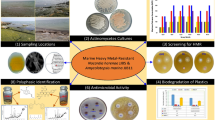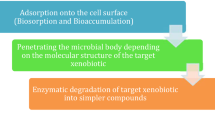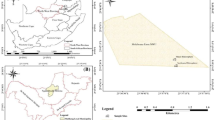Abstract
Long-term use of toxic pesticides in agricultural grounds has led to adverse effects on the environment and human health. Microbe-mediated biodegradation of pollutants is considered an effective strategy for the removal of contaminants in agricultural and environmental sustainability. Imidacloprid, a neonicotinoid class of pesticides, was widely applied insecticide in the control of pests in agricultural fields including the tea gardens of Assam. Here, native bacteria from imidacloprid contaminating tea garden soils were isolated and screened for imidacloprid degradation efficiency under laboratory conditions. Out of the 30 bacterial isolates, 4 were found to tolerate high concentrations of imidacloprid (25,000 ppm), one of which isolate MBSB-12 showed the highest efficiency for imidacloprid tolerance and utilization as the sole carbon source. Morphological, biochemical, and 16 S ribosomal RNA gene sequencing-based characterization revealed the isolate as Pseudomonas plecoglossicida MBSB-12. The isolate reduced 87% of extractable imidacloprid from the treated soil in 90 days compared to the control soil (without bacterial treatment). High-Resolution Mass Spectrometry (HRMS) analysis indicated imidacloprid breakdown to comparatively less harmful products viz., imidacloprid guanidine olefin [m/z = 209.0510 (M + H)+], imidacloprid urea [m/z = 212.0502 (M + H)+] and a dechlorinated degraded product of imidacloprid with m/z value 175.0900 (M + H)+. Further investigation on the molecular machinery of P. plecoglossicida MBSB-12 involved in the degradation of imidacloprid is expected to provide a better understanding of the degradation pathway.





Similar content being viewed by others
References
Abdullah RR, Ghani SBA, Sukar NA (2016) Degradation of profenofos and λ-cyhalothrin using endogenous bacterial isolates and detection of the responsible genes. J Bioremed Biodegr 7:360
Aislabie J, Lloyd-Jones G (1995) A review of bacterial degradation of pesticides. Aust J Soil Res 33:925–942. https://doi.org/10.1071/SR9950925
Akoijam R, Singh B (2015) Biodegradation of imidacloprid in sandy loam soil by Bacillus aerophilus. 95:730–743. https://doi.org/10.1080/03067319.2015.1055470
Allison LE (1965) Organic carbon. Methods of Soil Analysis, Part 2: Chemical and Microbiological Properties 9:1367–1378. https://doi.org/10.2134/AGRONMONOGR9.2.C39
Anhalt JC, Moorman TB, Koskinen WC (2007) Biodegradation of imidacloprid by an isolated soil microorganism. https://doi.org/10.1080/03601230701391401 42:509–514.
Araújo ASF, Monteiro RTR, Abarkeli RB (2003) Effect of glyphosate on the microbial activity of two brazilian soils. Chemosphere 52:799–804. https://doi.org/10.1016/S0045-6535(03)00266-2
Bray R, Kurtz L (1945) Determination of total, organic, and available forms of phosphorus in soils. Soil Sci 59:39–46
Carson R (1962) Silent Spring. Houghton Mifflin, Boston, United States
Cullington J, Walker A (1999) Rapid biodegradation of diuron and other phenylurea herbicides by a soil bacterium. Soil Biol Biochem 31:677–686
Dai YJ, Ji WW, Chen T et al (2010) Metabolism of the neonicotinoid insecticides acetamiprid and thiacloprid by the yeast rhodotorulamucilaginosa strain IM-2. J Agric Food Chem 58:2419–2425. https://doi.org/10.1021/JF903787S
Dankyi E, Gordon C, Carboo D et al (2018) Sorption and degradation of neonicotinoid insecticides in tropical soils. J Environ Sci Health - Part B Pesticides Food Contaminants Agricultural Wastes 53:587–594. https://doi.org/10.1080/03601234.2018.1473965
Dourado MN, Franco MR, Peters LP et al (2015) Antioxidant enzymes activities of Burkholderia spp. strains—oxidative responses to Ni toxicity. Environ Sci Pollut Res 22:19922–19932. https://doi.org/10.1007/S11356-015-5204-1
English SG, Sandoval-Herrera NI, Bishop CA et al (2021) Neonicotinoid pesticides exert metabolic effects on avian pollinators. Sci Rep 11(1):1–11
de Erenchun N, de Balugera Z, Goicolea MA, Barrio RJ (1997) Determination of imidacloprid and its major metabolite in soils by liquid chromatography with pulsed reductive amperometric detection. AnalyticaChimicaActa 349:199–206
Finley S, Broadbelt LJ, Hatzimanikatis V (2010) Insilico feasibility of novel biodegradation pathways for 1, 2, 4-trichlorobenzene. BMC Syst Biol 4:7
Gautam P, Dubey SK (2022) Biodegradation of imidacloprid: Molecular and kinetic analysis. Bioresour Technol 350:126915
Giannopolitis CN, Ries SK (1977) Superoxide DismutasesI. Occurrence in higher plants. Plant Physiol 59:309–314. https://doi.org/10.1104/PP.59.2.309
Gopal M, Dutta D, Jha S et al (2011) Biodegradation of imidacloprid and metribuzin by Burkholderiacepacia strain CH9. Pesticide Res J 23:36–40
Guo L, Dai Z, Guo J et al (2020) Oligotrophic bacterium Hymenobacterlatericoloratus CGMCC 16346 degrades the neonicotinoid imidacloprid in surface water. AMB Express 10. https://doi.org/10.1186/S13568-019-0942-Y
Gupta M, Mathur S, Sharma T et al (2016) A study on metabolic prowess of Pseudomonas sp. RPT 52 to degrade imidacloprid, endosulfan and coragen. J Hazard Mater 301:250–258
Hallmann CA, Foppen RPB, Van Turnhout CAM et al (2014) Declines in insectivorous birds are associated with high neonicotinoid concentrations. Nature 511:341–343. https://doi.org/10.1038/nature13531
Hamada A, Wahl G, Nesterov A et al (2019) Differential metabolism of imidacloprid and dinotefuran by Bemisiatabaci CYP6CM1 variants. Pestic Biochem Physiol 159:27–33
Hazarika DJ, Goswami G, Gautom T et al (2019) Lipopeptide mediated biocontrol activity of endophytic Bacillus subtilis against fungal phytopathogens. BMC Microbiol 19:1–13. https://doi.org/10.1186/S12866-019-1440-8
He B, Liu Z, Wang Y et al (2021) Imidacloprid activates ROS and causes mortality in honey bees (Apis mellifera) by inducing iron overload. Ecotoxicol Environ Saf 228:112709
Holt JG, Krieg NR, Sneath PH (1994) Bergey’s Manual of Determinative Bacteriology, 9th edition. Williams and Wilkins, Baltimore
Hu G, Zhao Y, Liu B et al (2013) Isolation of an indigenous imidacloprid-degrading bacterium and imidacloprid bioremediation under simulated in situ and ex situ conditions. J Microbiol Biotechnol 23:1617–1626
Hussain S, Hartley C, Shettigar M, Pandey G (2016) Bacterial biodegradation of neonicotinoid pesticides in soil and water systems. FEMS Microbiol Lett 363:fnw252. https://doi.org/10.1093/femsle/fnw252
Ishtiaq F, Bhatti HN, Khan A, Iqbal M, Kausar A (2020) Polypyrole, polyaniline and sodium alginate biocomposites and adsorption-desorption efficiency for imidacloprid insecticide. Int J Biol Macromol 147:217–232
Jeschke P, Nauen R, Schindler M, Elbert A (2011) Overview of the status and global strategy for neonicotinoids. J Agric Food Chem 59:2897–2908. https://doi.org/10.1021/jf101303g
Kaushal J, Mehandia S, Singh G et al (2018) Catalase enzyme: application in bioremediation and food industry. Biocatal Agric Biotechnol 16:192–199
Khalil SR, Awad A, Mohammed HH, Nassan MA (2017) Imidacloprid insecticide exposure induces stress and disrupts glucose homeostasis in male rats. Environ Toxicol Pharmacol 55:165–174
Li Y, Miao R, Khanna M (2020) Neonicotinoids and decline in bird biodiversity in the United States. Nat Sustain 3:1027–1035. https://doi.org/10.1038/s41893-020-0582-x
Li Z, Shao T, Min H et al (2009) Stress response of Burkholderiacepacia WZ1 exposed to quinclorac and the biodegradation of quinclorac. Soil Biol Biochem 41:984–990
Lin Z, Zhang W, Pang S et al (2020) Current approaches to and future perspectives on methomyl degradation in contaminated soil/water environments. Molecules 25:738. https://doi.org/10.3390/molecules25030738
Lu TQ, Mao SY, Sun SL et al (2016) Regulation of hydroxylation and nitroreduction pathways during metabolism of the neonicotinoid insecticide imidacloprid by Pseudomonas putida. J Agric Food Chem 64:4866–4875. https://doi.org/10.1021/acs.jafc.6b01376
Lü Z, Sang L, Li Z, Min H (2009) Catalase and superoxide dismutase activities in a Stenotrophomonasmaltophilia WZ2 resistant to herbicide pollution. Ecotoxicol Environ Saf 72:136–143
Ma Y, Zhai S, Mao SY et al (2014) Co-metabolic transformation of the neonicotinoid insecticide imidacloprid by the new soil isolate Pseudoxanthomonasindica CGMCC 6648. Journal of Environmental Science and Health - Part B Pesticides. Food Contaminants and Agricultural Wastes 49:661–670. https://doi.org/10.1080/03601234.2014.922766
Maiti D, Chandra K, Mondal S et al (2008) Isolation and characterization of a heteroglycan from the fruits of Astraeushygrometricus. Carbohydr Res 343:817–824
Marco-Urrea E, Reddy CA (2012) In: Singh SN (ed) Degradation of Chloro-organic pollutants by White Rot Fungi BT - Microbial degradation of xenobiotics. Springer Berlin Heidelberg, Berlin, Heidelberg, pp 31–66
McLeod S (1973) Studies on wet oxidation procedures for the determination of organic carbon in soils. Notes on soil techniques. CSIRO Division of Soils, Canberra, Australia
Pandey G, Dorrian S, Russell RJ, Oakeshott JG (2009) Biotransformation of the neonicotinoid insecticides imidacloprid and thiamethoxam by Pseudomonas sp. 1G. Biochem Biophys Res Commun 380:710–740
Patel B, Jain S, Jagtap M et al (2014) Study of presence of available potassium in soil of LunawadaTaluka territory. Archives of Applied Science Research 6:79–84
Pathak VM, Verma VK, Rawat BS et al (2022) Current status of pesticide effects on environment, human health and its eco-friendly management as bioremediation: a comprehensive review.Frontiers in Microbiology,2833
Pedroso MM, Hine D, Hahn S et al (2021) Pesticide degradation by immobilized metalloenzymes provides an attractive avenue for bioremediation. EFB Bioeconomy Journal 1:100015
Phugare S, Kalyani D, Gaikwad Y, Jadhav J (2013) Microbial degradation of imidacloprid and toxicological analysis of its biodegradation metabolites in silkworm (Bombyx mori). Chem Eng J 230:27–35
Pooja (2017) Isolation and characterization of imidacloprid degrading bacteria. Doctoral Dissertation, Chaudhary Charan Singh Haryana Agricultural University (CCSHAU), Haryana. http://krishikosh.egranth.ac.in/handle/1/5810031702
Rana S, Jindal V, Mandal K et al (2015) Thiamethoxam degradation by Pseudomonas and bacillus strains isolated from agricultural soils. Environ Monit Assess 187:300. https://doi.org/10.1007/s10661-015-4532-4
Rouchaud J, Gustin F, Wauters A (1994) Soil Organic Matter Ageing and its Effect on Insecticide Imidacloprid Soil Biodegradation in Sugar Beet Crop. Toxicol Environ Chem 45:149–155. https://doi.org/10.1080/02772249409358078
Rovida AFdaS, Costa G, Santos MI et al (2021) Herbicides Tolerance in a Pseudomonas strain is Associated with metabolic plasticity of antioxidative enzymes regardless of selection. Front Microbiol 12. https://doi.org/10.3389/FMICB.2021.673211/FULL
Seifrtova M, Halesova T, Sulcova K et al (2017) Distributions of imidacloprid, imidacloprid-olefin and imidacloprid-urea in green plant tissues and roots of rapeseed (Brassica napus) from artificially contaminated potting soil. Pest Manag Sci 73:1010–1016. https://doi.org/10.1002/PS.4418
Selvam B, Graton J, Laurent AD et al (2015) Imidacloprid and thiaclopridneonicotinoids bind more favourably to cockroach than to honeybee α6 nicotinic acetylcholine receptor: insights from computational studies. J Mol Graph Model 55:1–12
Shahid M, Jabeen F, Hassan SW (2008) Isolation of imidacloprid degrading bacteria from cotton fields. Sci Int (Lahore) 20:285–293
Sharma N, Banerjee H, Pal S, Sharma KK (2018) Persistence of thiacloprid and deltamethrin residues in tea grown at different locations of North-East India. Food Chem 253:88–92
Sharma S, Singh B, Gupta VK (2014) Assessment of imidacloprid degradation by soil-isolated Bacillus alkalinitrilicus. Environ Monit Assess 186:7183–7193. https://doi.org/10.1007/S10661-014-3919-Y
Sharma T, Toor A, Rajor A (2015) Photocatalytic degradation of imidacloprid in soil: application of response surface methodology for the optimization of parameters. RSC Adv 5:25059–25065
Siripattanakul-Ratpukdi S, Vangnai AS, Sangthean P, Singkibut S (2015) Profenofos insecticide degradation by novel microbial consortium and isolates enriched from contaminated chili farm soil. Environ Sci Pollut Res 22:320–328
Subsanguan T, Vangnai AS, Siripattanakul-Ratpukdi S (2020) Aerobic and anoxic degradation and detoxification of profenofos insecticide by Pseudomonas plecoglossicida strain PF1. Ecotoxicol Environ Saf 190:110129. https://doi.org/10.1016/j.ecoenv.2019.110129
Suchail S, De Sousa G, Rahmani R, Belzunces LP (2004) In vivo distribution and metabolisation of 14 C-imidacloprid in different compartments of Apismellifera L. Pest Manag Sci 60:1056–1062. https://doi.org/10.1002/PS.895
Sur R, Stork A (2003) Uptake, translocation and metabolism of imidacloprid in plants. Bull Insectol 56:35–40
Tamura K, Stecher G, Peterson D et al (2013) MEGA6: molecular evolutionary genetics analysis version 6.0. Mol Biol Evol 30:2725–2729
Vignet C, Cappello T, Fu Q et al (2019) Imidacloprid induces adverse effects on fish early life stages that are more severe in japanese medaka (Oryzias latipes) than in zebrafish (Danio rerio). Chemosphere 225:470–478
Viji R, Prasanna P (2012) Assessment of water holding capacity of major soil series of Lalgudi, Trichy, India. J Environ Res Dev 7:393–398
Wilson C (2000) Environmental and human costs of commercial agricultural production in South Asia. Int J Soc Econ 27:816–846. https://doi.org/10.1108/03068290010335244
Yu B, Chen Z, Lu X et al (2020) Effects on soil microbial community after exposure to neonicotinoid insecticides thiamethoxam and dinotefuran. Sci Total Environ 725:138328
Zhang P, Ren C, Sun H, L M (2018) Sorption, desorption and degradation of neonicotinoids in four agricultural soils and their effects on soil microorganisms. Sci Total Environ 615:59–69
Zhang Y, Meng D, Wang Z et al (2012) Oxidative stress response in atrazine-degrading bacteria exposed to atrazine. J Hazard Mater 229:434–438. https://doi.org/10.1016/j.jhazmat.2012.05.054
Zhou X, Tian Y, Liu X et al (2018) Reduction of Imidacloprid by Sponge Iron and Identification of its Degradation Products. Water Environ Res 90:2049–2055. https://doi.org/10.2175/106143017X15131012188187
Acknowledgements
The authors are grateful to the Department of Agricultural Biotechnology, Assam Agricultural University and DBT - North East Centre for Agricultural Biotechnology, Assam Agricultural University for providing the required facilities and laboratory space for conducting the research works. The authors are also thankful to CSIR-North East Institute of Science and Technology, Jorhat, Assam for providing the instrumentation facility for HRMS analysis. Special thanks to Dr. Rajiv Das Kangabam for his kind help and suggestions.
Funding
SB received scholarship from Department of Biotechnology, Ministry of Science and Technology, Government of India through DBT-North East Centre for Agricultural Biotechnology, Assam Agricultural University, Jorhat, Assam.
Author information
Authors and Affiliations
Contributions
MB* conceived the idea; MB*, SB and DJH designed the study; MG supervised the sampling; SB performed the experimental analyses, prepared the draft manuscript and the figures; SB, DJH, MB and SSB performed data analysis and instrumentation support; MB* and RCB provided technical supervision during the study; DJH, SSB, RCB and MB* critically revised the manuscript; All authors have contributed, read and agreed to the content of the of the manuscript.
Corresponding author
Ethics declarations
Conflict of interest
The authors declare that they have no conflict of interests.
Additional information
Publisher’s note
Springer Nature remains neutral with regard to jurisdictional claims in published maps and institutional affiliations.
Rights and permissions
Springer Nature or its licensor (e.g. a society or other partner) holds exclusive rights to this article under a publishing agreement with the author(s) or other rightsholder(s); author self-archiving of the accepted manuscript version of this article is solely governed by the terms of such publishing agreement and applicable law.
About this article
Cite this article
Borah, S., Hazarika, D.J., Baruah, M. et al. Imidacloprid degrading efficiency of Pseudomonas plecoglossicida MBSB-12 isolated from pesticide contaminated tea garden soil of Assam. World J Microbiol Biotechnol 39, 59 (2023). https://doi.org/10.1007/s11274-022-03507-x
Received:
Accepted:
Published:
DOI: https://doi.org/10.1007/s11274-022-03507-x




